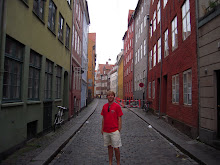
There are some who have the profession but who also suffer from these dreaded feelings of nothingness, much like the never-named-but-known-as-Thomas protagonist of Michelangelo Antonioni’s Blow-Up. Thomas is a fashion photographer, a well-known one, judging by the parade of doll-like 20 something female models that stalk him, whose job it is to create meaning in his photo shoots. We assume Thomas shoots for some high-end clothing companies, but it seems that his real desire is to create an art book, filled with images from homeless shelters and the pictures he takes of the couple in the park. The posed, superficial, even exploitative high fashion photos contrast greatly to the organically obtained homeless shelter images and especially to the park photos. Thomas associates different meanings to these two separate forms of photography, as noted by his lifeless attitude post-fashion photos and his comically over joyous heel kick after snapping the park pictures.
But a creation is always a creation. When Thomas develops the photos from the park and soon discovers a gunman in the bushes, he frantically and obsessively begins to blow-up the resolution of the images, distorting the quality and thus losing the truth in the distorted, grainy, now abstract images he’s left with. When he puts his P.I cap on and returns to the scene, the body looks fake and no further evidence is found. His search has led him again to nothingness.

Thomas’ experience with the park murder and his photo “evidence” exemplifies the existential elusiveness of meaning. Thomas, fed up with the vapid models and photo shoots that make up his daily existence, jumps (literally) at the chance to propel his profession to a higher overall reason for being. But it turns out his work does nothing but waste time and materials. Creations only have the meaning individuals give them, Blow-Up reminds us. The piece of the guitar from the Yardbirds concert is left as trash on the ground because it doesn’t mean anything to the passersby. The fake tennis match between the mimes only has meaning because everyone is believes in it. Thomas leaves the guitar piece on the ground. Thomas realizes he must buy into the mime tennis match for it to have meaning.
Between these experiences, Thomas learns that his creations, despite the subject matter, are inexorably linked to a sense of falsity, and that finding meaning in them is as elusive as finding life’s meaning.
